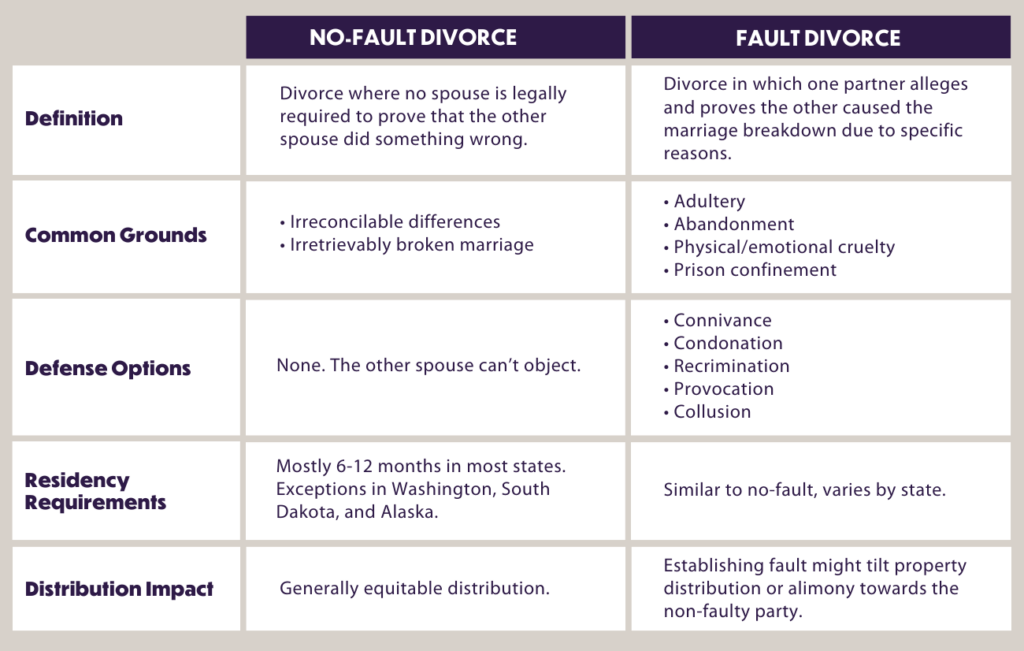Navigating a divorce can feel like trying to solve a puzzle but understanding the differences between “no-fault” and “fault” divorce can make things clearer. As you go through this complicated journey, take a deep breath and allow us to break things down for you.
A Quick Introduction
In 1969, the nation’s first no-fault divorce bill was signed by then California governor, Ronald Reagan. In the years that followed, nearly every other state established a no-fault divorce law of its own. Prior to no-fault divorce laws, one partner had to prove that the other was, well, a pretty bad spouse. This could be due to adultery, desertion, cruelty, and other misdeeds. No-fault divorce made it possible to divorce without the blame game.
No-Fault vs. Fault Divorce At a Glance

Breaking Down No-Fault Divorce
A no-fault divorce is one where the person initiating the divorce doesn’t need to point fingers or prove that the other did anything wrong.
Key Points:
- Universality: Every state in the U.S. recognizes no-fault divorce. However, as of 2023, only 17 states along with the District of Columbia are deemed “true” no-fault divorce regions. In these areas, you don’t have the choice to cast blame on fault grounds.
- Grounds for No-Fault Divorce: Typically, these involve vague terms that signal the end of the marriage, like irreconcilable differences, or that the marriage is irretrievably broken.
- No Room for Objections: If one party pushes for a no-fault divorce, the other can’t object. Any such objection could itself be viewed as an irreconcilable difference.
- Duration Matters: Often, there’s a waiting period, and spouses might need to live separately for a specified time before filing.
Breaking Down Fault Divorce
A rarer approach nowadays, the fault divorce demands one spouse to demonstrate the other’s mistakes or behavior.
Accepted Grounds for Fault Divorce:
- Adultery
- Abandonment over a defined period
- Prison confinement
- Undisclosed physical inability to engage in sexual intercourse prior to marriage
- Infliction of physical or emotional pain (cruelty)
One notable difference between the two: in a fault divorce, you typically don’t need to live separately before filing. In addition, establishing fault might tilt property distribution or alimony towards the aggrieved party.
Defending Fault Claims:
Unlike the straightforward no-fault route, fault divorces can be contested:
- Connivance: This is primarily used against claims of adultery, suggesting the accusing partner played a part or even consented.
- Condonation: Suggesting the offended spouse knew and forgave the misdeed.
- Recrimination: Both parties are at fault, e.g., both committed adultery.
- Provocation: One spouse instigated the other’s faulted action.
- Collusion: The couple conspired to fabricate divorce grounds.
Proving these defenses can be quite costly, requiring testimonies and comprehensive evidence. With courts inclined to grant divorces upon request, these defenses are sometimes more hassle than they’re worth.
The Geographic Consideration
Most states have residency requirements demanding that one of the spouses must have lived in the state for 6-12 months before filing for divorce. Remember, Washington, South Dakota, and Alaska are exceptions with no stipulated durations.
Here’s a scenario to consider: Suppose you obtained your divorce in Illinois but moved to Missouri years later. If you wish to alter child custody or support, you’ll be revisiting that Illinois court, as it retains jurisdiction over any modifications.
All states respect divorce decisions made elsewhere in the U.S., courtesy of the Full Faith and Credit Clause of the U.S. Constitution. Things can get more complicated if the divorce decision involves a non-resident spouse or if it’s international.
Which is Better?
It’s not about better or worse, but rather what fits your situation best.
- Consider Your Emotional Well-Being: A fault divorce can be more emotionally taxing because it involves proving a partner’s misdeeds. If you’d rather skip that drama and heartache, no-fault divorce might be the route for you.
- Think About Time and Money: If you’re looking for a quicker process and potentially lower legal costs, no-fault divorce might be the better option.
- Potential Benefits: In some cases, if you can prove your spouse was at fault, it might affect things like alimony or child custody in your favor. This could make the fault route worth the effort.
- Jurisdiction Matters: Keep in mind that some states are exclusively no-fault divorce states. Before you strategize, know the laws in your jurisdiction.
Divorce isn’t easy, no matter which route you take. It’s a big decision, and what’s most important is that you choose the path that feels right for you. Arm yourself with knowledge and make the choice that best serves your needs. Don’t forget to also take care of your emotional well-being and find a support system to help guide you through this challenging time (our very own Split.fyi community is a great support system!). You’ve got this!
